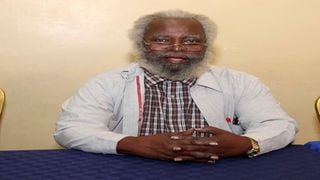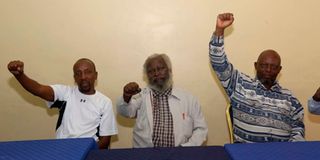
Prof Ngotho Kariuki during the interview at United Kenya Club on February 17, 2022.
| Lucy Wanjiru | Nation Media GroupNews
Premium
Reliving the horrors of Nyayo House torture chambers
It’s been 18 years since the Nyayo torture chambers were opened to the public. But for Prof Ngotho Kariuki, a tax expert and political and human rights activist, memories of his detention during the fight for multiparty democracy remain fresh.
He recalls sleeping on a cold floor, wondering whether extremely cold or hot water would wake him up. A live snake would be dropped into the water by security guards, and he would have to keep moving, eyes always on the snake, for fear of being bitten.
He and his fellow detainees would be ordered to strip naked and walk or jump in front of male and female security guards, and the guards would refer to the chambers as graves of the living.
With fondness, he tells of a kind security guard who, when others were not around, would give them food and allow them to sit on a dry surface. He would comfort them and tell them that it would all be okay. If only Prof Kariuki would meet him now to say thank you.
More than four decades and a book later, Prof Kariuki, detained alongside ODM leader Raila Odinga in 1986, has only one plea: We must not forget what they went through, even though it is a painful and shameful past.
On Friday, he and other former detainees will visit the torture chambers. For Prof Kariuki, it will be the first time in more than 10 years that he will be stepping into the cells, having visited them when Mr Odinga was prime minister.
“Nyayo House was built as an ordinary building and we the survivors who were there know we won’t be here for a long time,” Prof Kariuki says.
“We would like to request a programme where the history of the Nyayo House torture chambers will be written to be preserved for future generations. The funds should be provided by the state,” he says.
“We also want to find out from the government when it became necessary to establish torture chambers. There are some people who say its design came from South Africa, others say it came from Romania. We also want the chambers to be gazetted as a monument, even if it will be called a monument of shame.”
He has detailed his detention experience in his book Two Weeks in Hell.
Though grateful that his father is alive, Kiiru Ngotho, who was only six when Prof Kariuki was detained, says he now understands why they changed houses when he was young and why friends and some family members suddenly stopped interacting with them.
For his part, Tee Ngugi, son of celebrated author Ngugi wa Thiongo, explains that even though his involvement is only by association, his childhood was severely impacted.

Former Nyayo torture chambers victims Prof Ngotho Kariuki (centre), James Maina (right) and Wachira Idaheire during the interview at United Kenya Club on February 17, 2022.
“When we have these sites, they contextualise our situation as a country, from where we derive our value system,” he said.
“When you go to the Nyayo House basement and ask yourself about the people who were tortured, why, and what kind of people they were, you will realise they were selfless people who sacrificed themselves for an idea bigger than themselves.
“I think those same ideas and values are what this country lacks, yet they are important in building a nation. When he left, security personnel put a lot of pressure on us to get to him. We would receive death threats on phone calls, people stopped associating with us, and on television, we would watch people burning an effigy of my father and chanting, ‘Maliza hao’, while demonstrating in the streets. It was traumatizing.”
Tee Ngugi will visit the chambers for the first time ever, and he is anxious about it.
Wachira Waheire, the secretary of the Centre for Memory and Development and the coordinator of National Victims and Survivors Network, explains that there is a need to repair the lives of people whose lives were shattered by death, injury and loss of property in the struggle for democracy.
The reparations can be in the form of monetary compensation, medical intervention and apologies from the government.
“Forgetting the history of these chambers will not bring closure to victims who feel there is no acknowledgement of the harm that was done,” he says.
“The chambers were supposed to be memorialised in 2002 (but) it is yet to be done. And, in fact, they were gazetted as protected areas.
He said President Uhuru Kenyatta in 2015 acknowledged what happened and issued an apology. “He also ordered the setting up of a restorative justice fund worth Sh10 billion to help in compensating victims, but the fund has yet to be operationalised.”
Though the chambers were declared open to the public, he says, they are still inaccessible, and activists are “worried that people may be experiencing torture in the very rooms our survivors stayed in”.
“If these stories are never told, there is a risk of people coming in the future and repeating what happened,” he says.
“We should not forget.”





